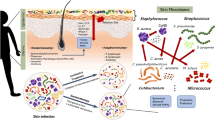Abstract.
Human skin is permanently exposed to microorganisms, but rarely infected. One reason for this natural resistance might be the existence of a ‘chemical barrier’ consisting in constitutively and inducibly produced antimicrobial peptides and proteins (AMPs). Many of these AMPs can be induced in vitro by proinflammatory cytokines or bacteria. Apart from being expressed in vivo in inflammatory lesions, some AMPs are also focally expressed in skin in the absence of inflammation. This suggests that non-inflammatory stimuli of endogenous and/or exogenous origin can also stimulate AMP synthesis without inflammation. Such mediators might be ideal ‘immune stimulants’ to induce only the innate antimicrobial skin effector molecules without causing inflammation.
Similar content being viewed by others
Author information
Authors and Affiliations
Corresponding author
Additional information
Received 9 August 2005; received after revision 21 October 2005; accepted 16 November 2005
Rights and permissions
About this article
Cite this article
Schröder, J.M., Harder, J. Antimicrobial skin peptides and proteins. Cell. Mol. Life Sci. 63, 469–486 (2006). https://doi.org/10.1007/s00018-005-5364-0
Published:
Issue Date:
DOI: https://doi.org/10.1007/s00018-005-5364-0




